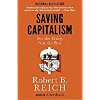
Donald Trump poses as a working-class populist, but about his new economic plan would be a gusher for the wealthy. And almost nothing will trickle down to anyone else.
He’d knock down the top tax rate on businesses from 35 percent to 15 percent, thereby richly rewarding the investor class.
He’d cut taxes the top tax rate on the wealthy from 39.6 percent to 33 percent, another boon to the top.
He’d eliminate the estate tax – now paid by a relative handful of families whose net worth exceeds $5.5 million.
Not incidentally, this is an especial windfall for the Trump family. If Trump is worth as much as he says, his heirs would get a tax break of $4 billion to $7 billion.
He’d let global corporations pay just a 10 percent tax rate on untaxed offshore profits – another mammoth gift to big shareholders.
Consider: Apple, Pfizer, Microsoft and other global American corporations hold $2.4 trillion in earnings abroad. They owe some $700 billion in taxes on these earnings. Trump’s 10 percent tax rate would raise only about $150 billion. It wouldn’t even generate new investment in America. A tax amnesty was tried in 2004 and it was a dud.
Yes, he’d also lower taxes on lower-income Americans. But the biggest beneficiaries by far are the wealthy.
Trump says his tax cuts would cost $4.4 trillion over 10 years. He claims most of it would be paid for by economic growth.
We’ve been here before.
Both Ronald Reagan and George W. Bush tried supply-side “trickle-down” economics. We should have learned two lessons.
First, nothing trickles down. The giant tax cuts on the wealthy enacted by Reagan in the 1980s and Bush in the 2000s enriched those at the top – but the wages of the bottom 60 percent went nowhere.
Second, such tax cuts produce giant budget deficits. Under Reagan and George H.W. Bush, the federal budget deficit exploded. It took Bill Clinton’s administration (of which I was proud to have been a member) to get the budget back in some semblance of balance.
Then, under George W. Bush, what happened? The deficit exploded again.
Trump would do all this on a far grander scale. He’s also proposing a vast expansion of the military, including 90,000 new soldiers for the Army and nearly 75 new ships for the Navy. The tab: an estimated $90 billion a year in additional spending.
This would mean big bucks for military contractors. But it’s hard to see how economic benefits trickle down to anyone else.
Perhaps Trump is banking on an indirect fiscal stimulus – the kind of “military Keynesianism” Ronald Reagan employed to fuel growth in the 1980s. But as we learned then, this sort of growth doesn’t trickle down, either.
Trump also pledges a gigantic infrastructure building program to “build the next generation of roads, bridges, railways, tunnels, sea ports, and airports.”
Hillary Clinton has proposed spending $275 billion on infrastructure over five years.
The Donald is thinking much bigger. “Her number is a fraction of what we’re talking about,” says Trump. “We need much more money to rebuild our infrastructure. I would say at least double her numbers, and you’re going to really need a lot more than that.”
Okay, so let’s call this $500 billion over five years.
Trump doesn’t stop there. A “foundation” of his economic plan, he says, is to renegotiate Nafta, bring trade cases against China, and “replace the present policy of globalism – which has moved so many jobs and so much wealth out of our country –with a new policy of Americanism.”
Who would benefit from a retreat from globalism? Maybe giant American corporations that don’t export from the U.S. because they already make things abroad for sale in foreign markets. But not average Americans, who’d have to pay more for just about everything.
Choking off trade won’t result in more good jobs in America. Trump says his trade policy will bring back manufacturing to the United States. But today’s factories are automated. Even in China, numerical-controlled machine tools and robots are replacing humans.
Oh, and Trump also wants to scrap many environmental, health, and safety regulations. He says this will further stimulate growth.
It’s another form of trickle-down nonsense. Even if we could get more growth by scrapping such regulations, growth isn’t an end in itself. The goal is a higher standard of living for most Americans.
If our air and water are unhealthy, if we’re subject to more floods and draughts (especially lower-income Americans who can’t afford to protect themselves and their homes from the devastation), if our workplaces and our food are unsafe, what’s the consequence? Our standard of living drops.
Trickle-down economics has proven itself a cruel hoax. It’s cruel because it rewards people at the top who least need it and hurts those below who are in greatest need. It’s a hoax because nothing trickles down.
Trump’s “yuge” trickle-down economics would be an even bigger bamboozle.
About the Author
 ROBERT B. REICH, Chancellor’s Professor of Public Policy at the University of California at Berkeley, was Secretary of Labor in the Clinton administration. Time Magazine named him one of the ten most effective cabinet secretaries of the last century. He has written thirteen books, including the best sellers “Aftershock" and “The Work of Nations." His latest, "Beyond Outrage," is now out in paperback. He is also a founding editor of the American Prospect magazine and chairman of Common Cause.
ROBERT B. REICH, Chancellor’s Professor of Public Policy at the University of California at Berkeley, was Secretary of Labor in the Clinton administration. Time Magazine named him one of the ten most effective cabinet secretaries of the last century. He has written thirteen books, including the best sellers “Aftershock" and “The Work of Nations." His latest, "Beyond Outrage," is now out in paperback. He is also a founding editor of the American Prospect magazine and chairman of Common Cause.
Books by Robert Reich
Saving Capitalism: For the Many, Not the Few -- by Robert B. Reich
 America was once celebrated for and defined by its large and prosperous middle class. Now, this middle class is shrinking, a new oligarchy is rising, and the country faces its greatest wealth disparity in eighty years. Why is the economic system that made America strong suddenly failing us, and how can it be fixed?
America was once celebrated for and defined by its large and prosperous middle class. Now, this middle class is shrinking, a new oligarchy is rising, and the country faces its greatest wealth disparity in eighty years. Why is the economic system that made America strong suddenly failing us, and how can it be fixed?
Click here for more info or to order this book on Amazon.
Beyond Outrage: What has gone wrong with our economy and our democracy, and how to fix it -- by Robert B. Reich
 In this timely book, Robert B. Reich argues that nothing good happens in Washington unless citizens are energized and organized to make sure Washington acts in the public good. The first step is to see the big picture. Beyond Outrage connects the dots, showing why the increasing share of income and wealth going to the top has hobbled jobs and growth for everyone else, undermining our democracy; caused Americans to become increasingly cynical about public life; and turned many Americans against one another. He also explains why the proposals of the “regressive right” are dead wrong and provides a clear roadmap of what must be done instead. Here’s a plan for action for everyone who cares about the future of America.
In this timely book, Robert B. Reich argues that nothing good happens in Washington unless citizens are energized and organized to make sure Washington acts in the public good. The first step is to see the big picture. Beyond Outrage connects the dots, showing why the increasing share of income and wealth going to the top has hobbled jobs and growth for everyone else, undermining our democracy; caused Americans to become increasingly cynical about public life; and turned many Americans against one another. He also explains why the proposals of the “regressive right” are dead wrong and provides a clear roadmap of what must be done instead. Here’s a plan for action for everyone who cares about the future of America.
Click here for more info or to order this book on Amazon.





























